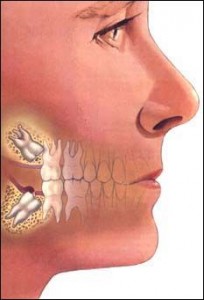 Contrary to popular belief, wisdom teeth do not make you smarter. Otherwise known as your third molars, they are simply your third set of molar teeth that develop around the age of 18- 21 in young men and women.
Contrary to popular belief, wisdom teeth do not make you smarter. Otherwise known as your third molars, they are simply your third set of molar teeth that develop around the age of 18- 21 in young men and women.
Why then do wisdom teeth cause so many problems and need to be removed? Simply because in most people there is not enough room in the jaw bone for the wisdom teeth to erupt. One doctor put it best when he said that you are trying to put 32 teeth in an area where there is only room for 28.
Often times wisdom teeth become impacted in the jawbone. Impacted means that the tooth is either covered by your gum tissue called a soft tissue impaction, or covered by bone called a hard tissue impaction. Some of the problems wisdom teeth can cause include a common called pericornitis.
Pericornitis is an infection of the gum tissue around partially impacted (meaning only part of the tooth is visible above the gum line) wisdom teeth. Because only part of the tooth is sticking out of the gums, this causes an area where food and plaque build up.
Wisdom teeth are usually in an area where it is extremely difficult to clean. Therefore the gum tissue becomes inflamed and irritated. Symptoms of pericornitis include pain, swelling and inability to open the mouth (called trismus) Treatment includes first relieving symptoms with antibiotics and mouth rinses and then removal of the wisdom tooth.
Destruction of bone can occur when the wisdom tooth is partially impacted. Because you cannot clean the area, plaque and tartar buildup in the back of the mouth. This can result not only in destruction of bone around the wisdom tooth but also around the molar tooth in front of the wisdom tooth. Due to their place in the mouth, wisdom teeth are more difficult to clean. The lack of hygiene in the posterior portion of the mouth can lead to a buildup of plaque.
A tooth that is more difficult to clean results in the formation of a cavity or decay on the tooth. When a wisdom tooth develops a cavity, it is better to remove the tooth than try to restore it with a filling. Removal of wisdom teeth can range from being a simple extraction to a minor surgical procedure depending on how much the tooth is impacted. If the wisdom tooth is fully erupted, then the tooth can be usually removed in one piece. If it is a full bony impaction, then the gums must be moved out of the way, and the bone removed to gain access to the tooth. The tooth is then removed in pieces because there is not enough room to remove the tooth and its roots in one piece. The gum tissue is sutured back and the area allowed to heal. Sutures or stitches may or may not be placed depending on the need of the individual case.
Dr. Lee is a hospital trained dentist. Our practice is experienced in bone grafting, platelet’s derived growth factors, biopsy, removal of teeth, implant surgery, etc. for patients of all age groups, and prepared to manage patients with all range of medical conditions.
